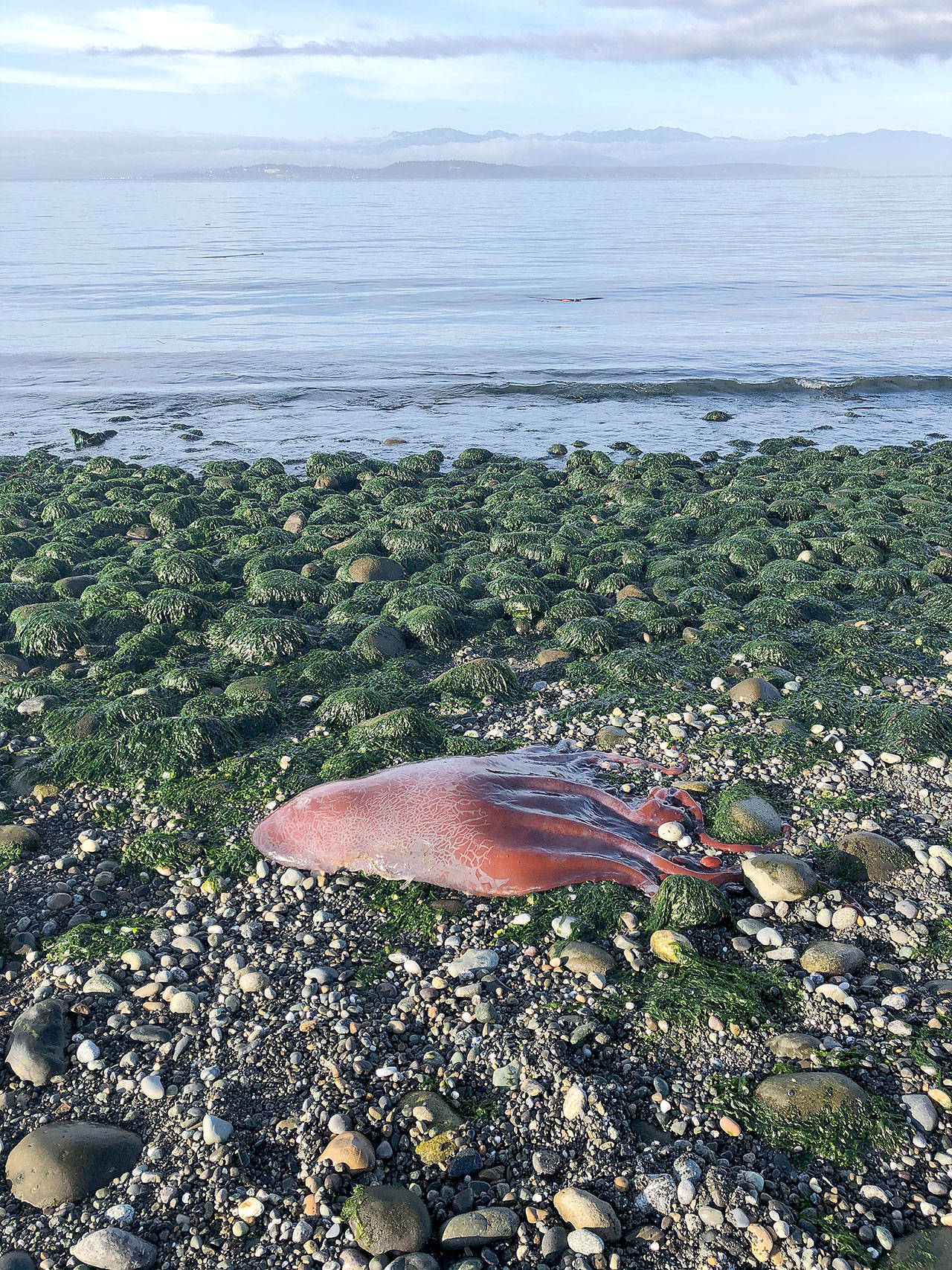EBEY’S LANDING — The tentacles of a deep-sea creature that washed up on a Whidbey Island beach have reached across the country.
Scientists from universities and research centers as far away as the Smithsonian Institution have identified it as a rare seven-armed octopus, although the conclusion isn’t unanimous.
Admirals Cove resident Ron Newberry sent the photo to the Whidbey News-Times, explaining he found the creature during low tide the morning of Aug. 29 on the beach at Ebey’s Landing.
“I didn’t know for sure it was an octopus,” Newberry said in an email. “It’s pretty common to see large jellyfish washed up on shore. Not knowing what it was, I definitely didn’t want to touch it. It also was obvious it was dead.”
He guessed the unknown creature was about 3½ feet long. Newberry posted a photo of the sea creature on the Whidbey Camano Land Trust social media pages, where it garnered a lot of attention. He said an engineer from the Seattle Aquarium thought it looked like a Dumbo octopus from the deep sea.
The News-Times sent the pictures to a University of Washington biology professor who also wasn’t sure what it was. That scientist sent it to some other biologists, who sent them to a few more.
“I confess my first thought was ‘something from outer space,’ so deep water offshore sounds similar,” said Dr. Megan Dethier, director of University of Washington Friday Harbor Labs. It “certainly doesn’t look like any of our local species.”
She sent the photos to some colleagues. Eventually, scientists from across the country were sucked into the challenge, including researchers at the Monterey Bay Aquarium Research Institute in California, the National Oceanic and Atmospheric Administration and the Smithsonian Institution.
Most agreed that it was a Haliphron atlanticus, also known as the seven-armed octopus.
Elaina Jorgensen of NOAA said the creature looked like it was in relatively good condition from the photos.
“I’ve seen photos of Haliphron from off the coast of British Columbia, so it’s not that unusual that they are this far north,” Jorgensen wrote in an email. “It’s possible this animal was blown into Puget Sound during the wind storm last week and died from our low salinity waters.”
Another expert had a little different view of the creature’s normal range.
“I was surprised that it was found in Puget Sound, which is pretty far north for that species,” wrote Michael Vecchione of the Smithsonian Institution in an email. “However, shifting distributions are not unusual in the world lately,”
Kirt Onthank, an associate professor at Walla Walla University, agreed that the specimen looks like a Haliphron atlanticus based on its jelly-like texture, size and shape.
Onthank studies the relationship between octopi and ocean acidification at Rosario Beach Marine Lab in Anacortes.
“So … that would be my best guess … as outlandish as it might seem at first,” he said in an email. “This is really interesting because I do not know of any records of this species from the Puget Sound area or from Washington state at all.”
Onthank explained that based on the creature’s skin, arms and mantle, it did not look like a decaying giant Pacific octopus as another scientist suggested.
Multiple scientists said they wished that they had DNA to confirm the theory.
Contrary to what its oxymoronic name suggests, the seven-armed octopus does not actually have just seven arms. Males appear to have just seven arms, but there is one more tucked up inside in a sac near its eye. It’s used for breeding. Females have eight unmodified arms. Unlike some octopi, Haliphron atlanticus swims all the time, similar to jellyfish.
“That’s why there is a reluctance among cephalopod researchers to refer to this species as ‘the seven-armed octopus,’” said Jorgensen.
The seven-armed sucker is at odds with another local kraken for the title of the world’s biggest octopus.
A biologist in New Zealand named Steve O’Shea found a huge specimen of Haliphron atlanticus. It was badly damaged and missing parts, and O’Shea estimated it would have weighed 75 kilograms, or 165 pounds, according to Onthank.
There’s a debate in the scientific community about whether the seven-armed octopus is the biggest, or if the giant Pacific octopus is, Onthank added. The latter has been spotted in waters off Whidbey Island.
The largest octopus that Onthank has seen was a giant Pacific octopus found near Driftwood Park in Coupeville.
He doesn’t know exactly how big it was because it was in its den.
“I could only see a few suckers and an eye,” he said. He guessed it was around 100 pounds with an arm span of 20 feet. “I was able to put my hand up to one of the suckers and it was nearly as big as the palm of my hand.”
Newberry said he’s seen a lot of wildlife all over Whidbey Island; this is just another to add to the list.
“I saw a family of river otters swimming about 10 minutes after I saw the octopus,” he said. “Porpoises are a common site from central Whidbey shores. Seals. Sea lions. You name it. Whidbey is a magical place.”
This story originally appeared in the Whidbey News-Times, a sister publication to The Herald.
Talk to us
> Give us your news tips.
> Send us a letter to the editor.
> More Herald contact information.


























